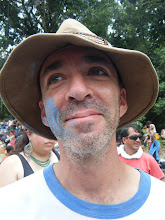Backtracking
In Bolivia I became quite lethargic with traveling, however, crossing the border into Peru completely rejuvenated me. I know it is just mental, but it's like the ink in the custom officer's stamp was mixed with magic fairy dust. I get back on the bus telling Mika that it feels like we are starting a new trip. It is a good thing to that I am reenergized because we are about to do some heavy duty traveling.
The first thing we have to do in Peru is backtrack. Nobody likes backtracking, but it is as good excuse as any for me to add links to my older blog posts. The first stop is Puno on the Peruvian side of Lake Titicaca. If you remember we were there during large protests (click the link to read about Puno). The central plaza was completely occupied by campesinos and the town was a mess. This time around the place seems to be pretty normal: the plaza is empty, stores are open and bank windows are not smashed. With no sight-seeing on the agenda we go to a Chinese restaurant that we went to before and go to bed early to catch our next bus to Arequipa.
 |
| Bring back the Classics: Watching Splash dubbed in Spanish on the bus |
 |
| Hello again alpacas in the national park near Arequipa |
 |
| Our salteña lady |
 |
| The tourist info said that we can't leave Arequipa without trying ricotta relleno (stuffed pepper), and we didn't. |
To the Beach and off the Trail
From Arequipa we make the very conscious decision to get off the tourist trail. While in Bolivia we never left it, and that scene can get tiring. We are commodities and a human-to-human element is lost during interactions with locals. Most tourists don't seem to care because either they have limited time with a "must-see" list, or they like guide books, hostels and restaurants that simplify backpacking to a sterile English-speaking environment, or they are Israeli.
The first place we go is Camana. During the summer this beach town is full of Arequipeños, but now is Peruvian winter and we might just be the only tourists international or local. The people at manning the tourist info desk inside the central library seem surprised to see us. To say that nothing is going on in Camana during their low season might be a grave understatement. An example: Our first night coincides with a woman from Camana being a contestant on a nationally televised game show. What's the big deal, right? Well, absolutely every single street level television in town is tuned into this program while the government is showing it on a giant screen in the central plaza to an audience of about fifty people. This is a huge event for Camana.
 |
| Camana market |
We settle in town not far from the plaza and take a long walk to the beach. Beeeeeaaaaaachchchchch! Ocean, waves, wind and sand rocks. Rocks. Camana does have one sandy beach a few kilometers away that we could reach by taxi, but it is too cold to swim anyway. I accept the rocks. We made it to the Pacific coast. Mission accomplished... sort of. Without much to do we just spend our time figuring out where to eat. Camana has a small, active market with people eating ceviches and chilcano (a fish soup) in the morning and at fried rice and noodle stalls at night. People in Camana are very nice to us. Tourists are rare but not totally uncommon. We are a mild curiosity not a commodity.
 |
| Chilcano: A typical breakfast in Camana |
 |
| Lapas in the market. We eat these several times without knowing what they are. One internet dictionary says 'lipset' a type of mollusk. Another said 'barnacle.' |
 |
| The Pacific Ocean |
 |
| Having our morning coffee in the market |
It's All About the Shrimp
 |
| Serious about their crustaceans: Camana's shrimp statue in the middle of town |
 |
| Popcorn shrimp sold on the street |
 |
| Sudado de camarones: a creamed tomato-based soup with a mountain of shrimp |
 |
| Cholesterol count? Chicharron of seafood and fish |
Last Stop
 |
| View of Chala and the ocean from our hotel |
View Larger Map
A) Copacabana, Bolivia B) Puno, Peru C) Arequipa, Peru
D) Camana, Peru E) Chala, Peru
Could somebody please tell me why the police officer in this cardboard cutout in front of Chala's police station is holding a lightsaber?






















































